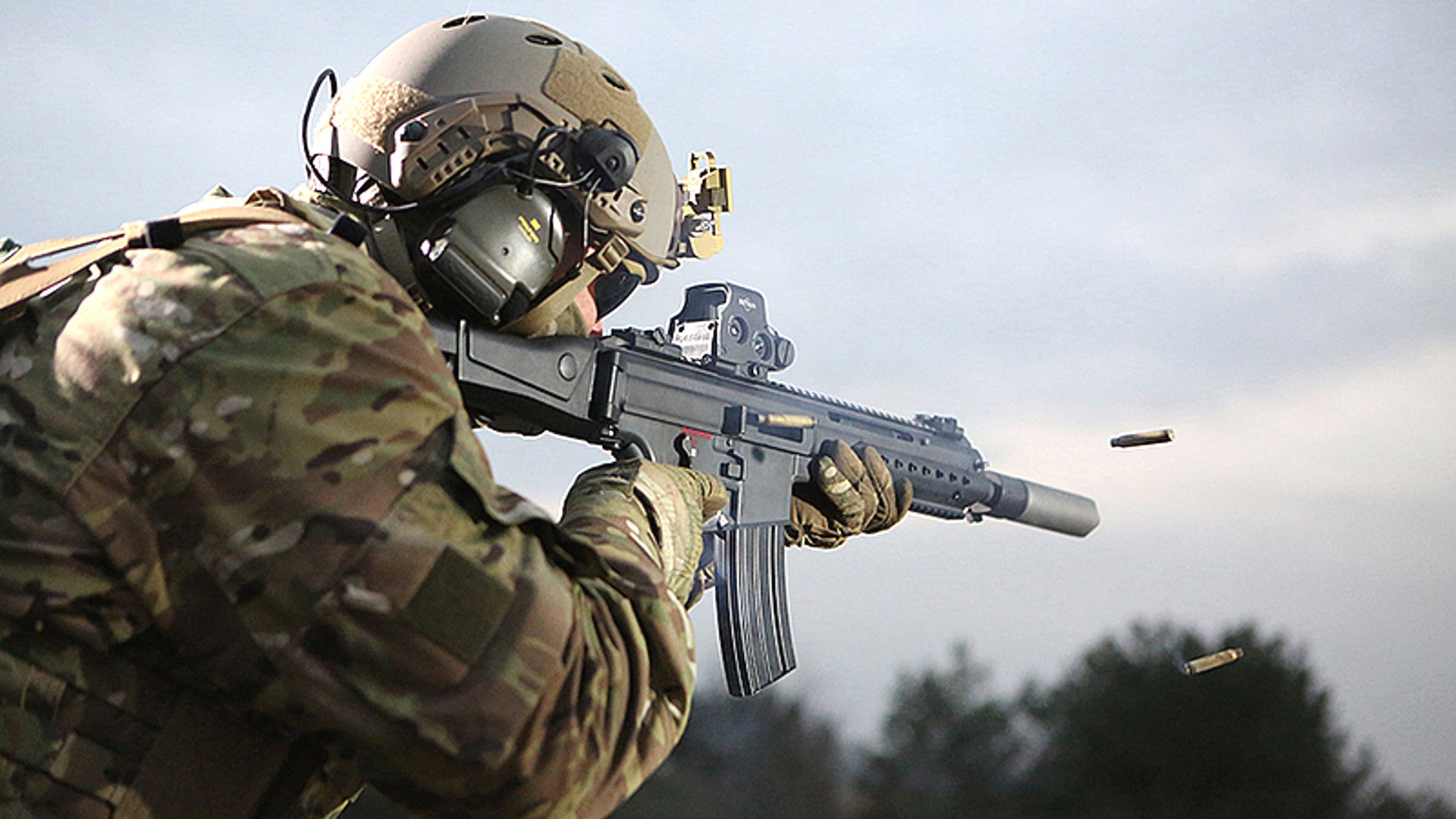A year after revealing its existence, German small arms manufacturer Heckler and Koch has brought examples of its new HK433 to the annual SHOT Show in Las Vegas, Nevada. H&K is now investing heavily in the modular gun, which combines many of the best features of the company’s existing G36 and HK416, as well as other popular designs, hoping it will win over the German Army.
Heckler and Koch quietly unveiled the gun in January 2017 and showed it to a select group of journalists in that year’s SHOT show. The HK 433 is now one of four different assault rifle patterns the company makes, including its earlier G36, which is the German Army’s present standard rifle, and its newer HK416 series, a derivative of the American AR-15/M16 pattern. The company also makes a rifle called the HK233, which is related to the G36, but features a system that allows the user to change the length of the barrel with relative ease.
“The new HK433 … combines the strengths and outstanding features of the G36 and the HK416 families of assault rifles – both proven worldwide,” the company’s website boasts. “It doesn’t matter at all whether you are right or left-handed or have trained on a G36 / HK416 weapon system or AR-15 platform: The HK433 is the solution for every scenario imaginable.”
That’s a typically outlandish marketing claim, but it doesn’t mean H&K hasn’t worked hard to make the gun as easy to adapt to different roles as possible. Unlike many of its past rifles, the HK 433 is a distinctly modular design with an emphasis on ergonomics and overall compact dimensions.
Without the need for any special tools, a user can swap out the barrel for one of a different length, making the weapon much more versatile for different mission sets. So far, the available barrels range from an 11-inch compact type to a 20-inch one suitable for turning the weapon into a marksman rifle.
H&K also designed the gun so that users can rapidly change to different calibers with a simple conversion kit that would include at least a new bolt and carrier assembly, barrel, and lower receiver assembly. The basic upper receiver shell can accept those different options without needing any other changes and has an ejection port that is wide and long enough to function properly with various different types of cartridges.
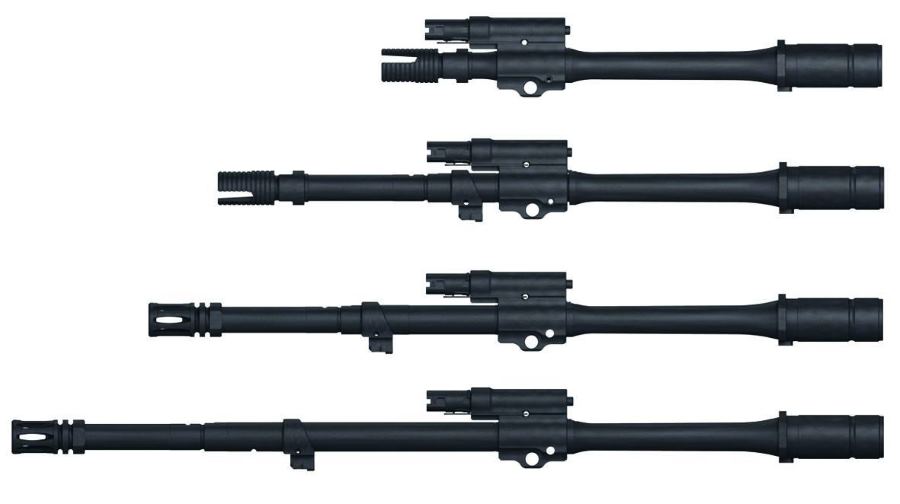
The main variant the company has put on display is an assault rifle chambered in the NATO-standard 5.56x45mm cartridge. However, the firm has said it may offer the weapons in the larger NATO-standard 7.62x51mm and the Soviet-developed 7.62x39mm, versions it is tentatively calling the HK 231 and 123 respectively. Another option could be the increasingly popular .300 Blackout, a specialized and highly adaptable cartridge that remains accurate and powerful even in very short-barreled guns and can be had in subsonic form, which you can read more about here.
The existing 5.56x45mm version of the HK433 also uses NATO-standard magazines, which will allow it to use the same ones as any AR-15/M16 pattern weapon or derivatives such as the HK416, as well as many other combat rifles. H&K has also offered a conversion kit that allows G36 rifles to do this, as well. As such, compatible magazines are already widely available to potential customers, which could be an important cost-saving selling point and interoperability feature.
On top of that, the HK433 has a number of basic features either inspired by or lifted directly from the company’s G36 and HK416 patterns. It also appears to be a product of some of the company’s other past efforts, such as its stillborn XM8 rifle for the U.S. Army, which had a similar modular design with elements taken from various successful guns, again including the G36 and the AR-15/M16 pattern.
The new HK433 uses a physical gas piston to cycle the action, as do both the G36 and HK416. This helps keep particulate matter away from vital internal components and reduces the likelihood that the gun might jam if it goes without routine cleaning for an extended period of time.

As with G36 and HK416, it also has an ambidextrous magazine release and selector switch to change the gun’s firing mode between safe, semi-automatic, and fully automatic. HK says it will offer those controls in the exact same styles as the existing weapons, making it easier for troops presently using either one to transition to the new rifle.
Unlike the AR-15/M16 but much like other popular combat rifles including the FN SCAR, the HK433 features a charging handle on the side of the upper receiver. This handle folds flush so as not to snag on things but is only on one side. The user can move it to the left or right relatively easily though. It takes an entire new upper receiver to have the gun eject shell casings to the left rather than the right, but a large deflector would likely keep the brass out a shooter’s face either way.
The gun’s buttstock completely folds to one side and has a wide range of length of pull adjustments, a big improvement over AR-15/M16 pattern rifles, and it includes an adjustable cheek rest to alter the cheek weld to the individual soldier. The latter feature can be an important issue, especially when using different kinds of optics, which might sit higher than typical iron sights. Shooters can swap out the pistol grips to give them the most ergonomic grip and the grip’s overall design is borrowed from the shape of the one found on HK416 which has proven to be very popular. .
It also has accessory rails all along the top of the rifle and underneath the handguard, as well as other attachment points along the side using the KeyMod system that American company VLTOR Weapon Systems developed. These two mechanisms will accept a wide array of different accessories, including grenade launchers, visible and infrared aiming lasers, flashlights, bipods, and vertical foregrips. It seems likely H&K could offer other mounting options, too, such as U.S. manufacturer Magpul’s increasingly popular M-LOK arrangement.
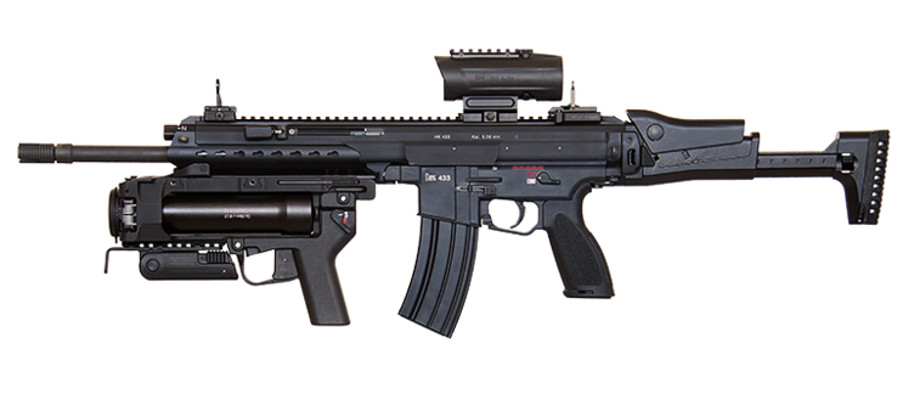
This level of modularity and ease in adding or removing accessories has long been a major selling point for the AR-15/M16 pattern and its derivatives. Other manufacturers have been pursuing similar new multi-purpose designs, such as Belgian firm FN Herstal’s SCAR family, which is in service with U.S. special operations forces, among others. The HK 433 has drawn direct visual and functional comparisons to the American Magpul Masada, another modular rifle concept that has since passed to a shared production arrangement between the Remington and Bushmaster Companies. H&K is itself also offering the HK233, which is essentially modular G36 variant.
H&K is clearly betting on this combination of desirable features being especially appealing to the German Army, which is looking to choose a replacement for its entire inventory of G36s by 2019. Germany first adopted the polymer-clad gun, which was fairly exotic when it was unveiled, as its existing standard service rifle in 1997.
If the service chooses the HK 433, the firm may be able to suggest that the country’s special operation forces could also replace their HK 416 and larger 7.62x51mm HK 417 rifles with this new modular rifle. Just getting the G36 deal would be a major boon for the company.. The German Army has more than 160,000 G36s and the final contract would likely be worth hundreds of millions of dollars. Other components of the German military and security apparatus also use the rifle and could be looking for replacements.
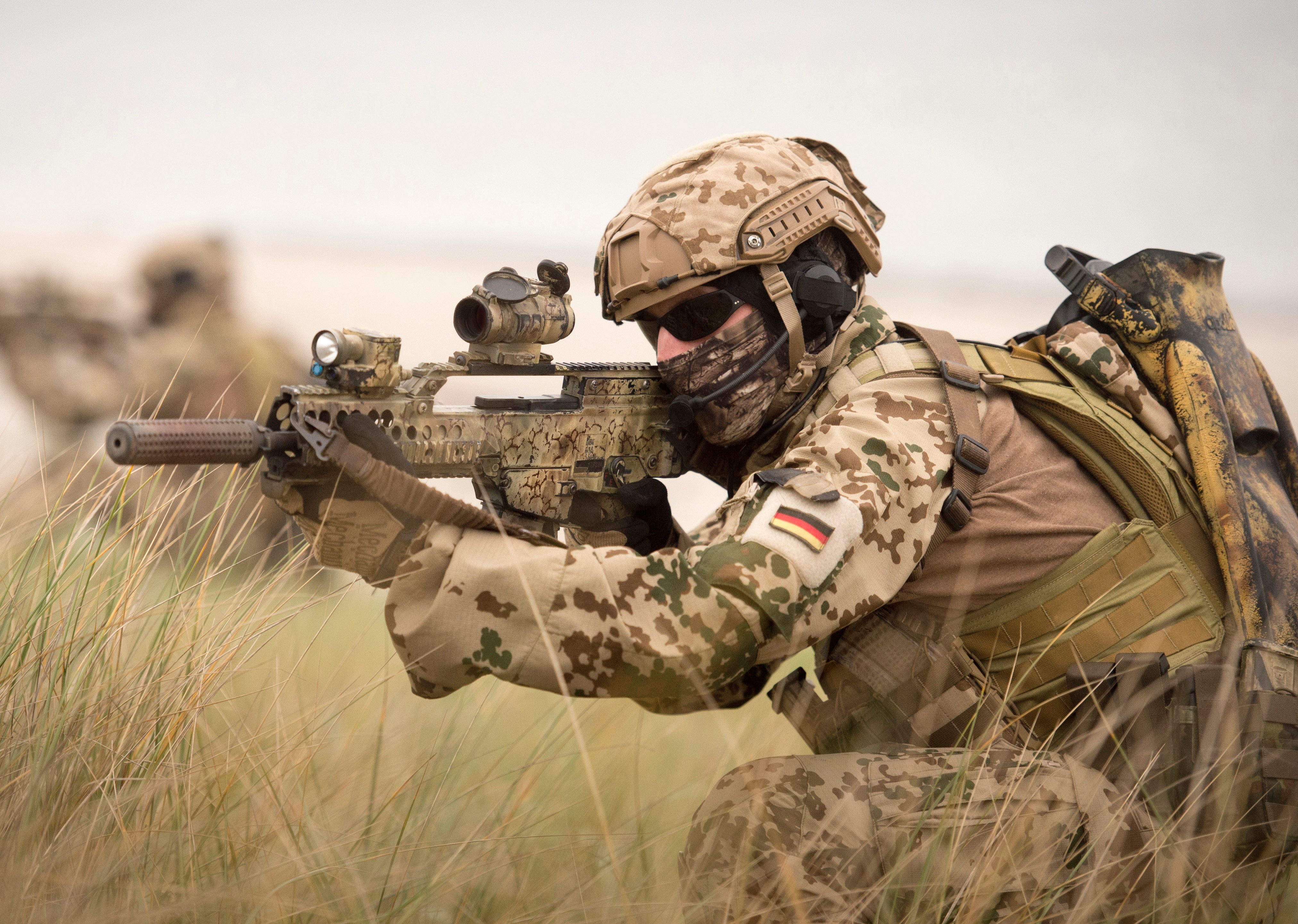
, A member of Germany’s Kommandos Spezialkräfte der Marine (KSM) with a heavily accessorized G36., Bundeswehr
But despite being a favorite in the competition, H&K still faces significant competition, including from two other German manufacturers, Rheinmetall and Haenel. Those companies are offering AR-15/M16 derivatives that, like the HK416, use a gas-piston operating method, as is Swiss gun manufacturer Sig-Sauer. The final entrant is FN Herstal with its SCAR rifle.
It’s possible German authorities may look to go with another company after decades of choosing HK to supply its standard infantry rifles. The country’s government got into a dispute with the firm over reported problems with the G36 performing poorly in hot weather based on the country’s own experiences in Afghanistan and reports from other users.
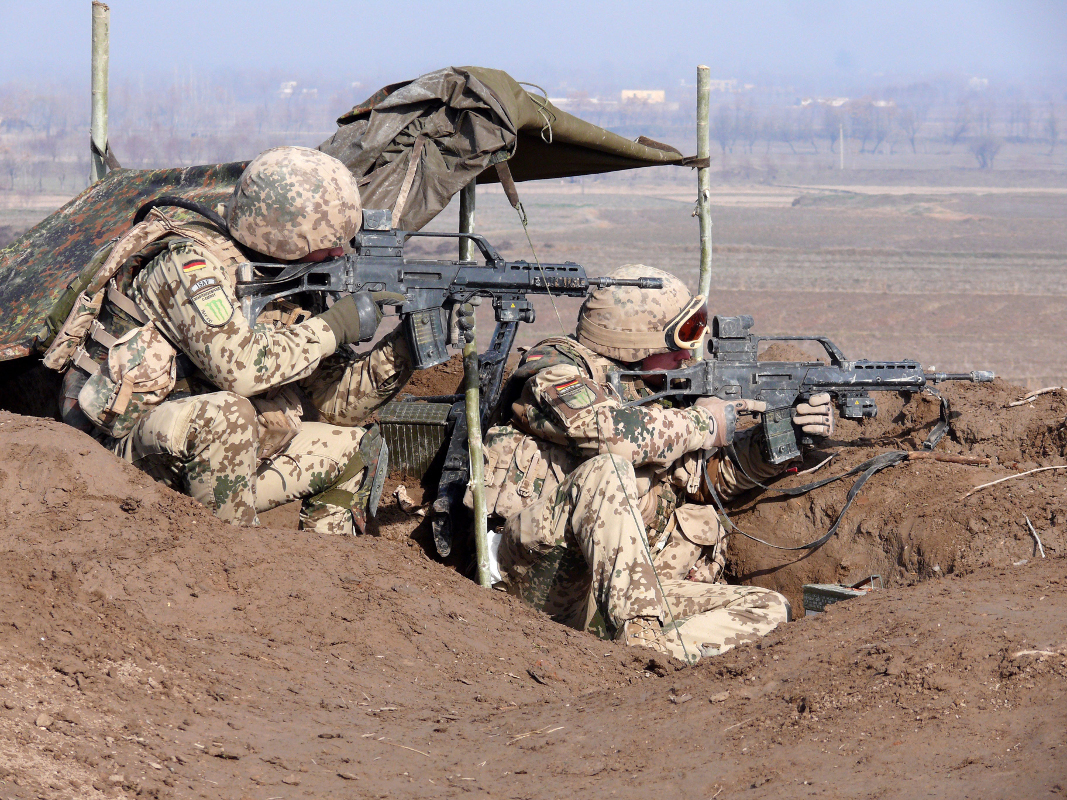
The German government subsequently sued H&K for breach of contract. A national court eventually ruled in the company’s favor in 2016, but on a technicality, stating that the deals didn’t cover the alleged faults. The gun maker has denied its weapons suffered dramatic drops in accuracy after overheating or otherwise malfunctioned more than could be expected from typical use.
If the German Army ultimately chooses another manufacturer, there are still a huge number of other military and police units around the globe that might be interested in replacing their rifles with H&K’s ultimate offering. And after years of spurning civilian shooters, H&K has sought to court those markets again with semi-automatic-only versions of many of rifles, but it still has to contend with both American and German import and export laws.
Germany will reportedly wrap up tests of the different contenders for its particular competition by the end of 2018. H&K has made a strong case for the country’s Army to stick with it once again in the form of the HK433.
Contact the author: joe@thedrive.com
